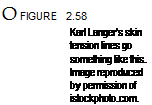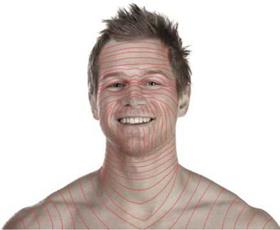As we grow, our bodies go through a series of remarkable physical changes of which we, as designers, must be acutely aware. The proportional change in the amount of lower face is perhaps the most fundamental aspect of facial growth. For example, as a child grows, the face grows downward and forward; the forehead becomes more upright and flat, and the lower part of the head (face) elongates downward and out.[35]
There are other outward manifestations as we grow through childhood into adolescence and puberty and then into adulthood. In fact, ossification—the hardening or calcification of soft tissue into bone—doesn’t usually occur fully until around age 25.
With the exception of primary sexual characteristics—that is, having either a penis or a vagina—male and female bodies are very similar during childhood. It isn’t until adolescence, when boys and girls begin to go through puberty, that noticeable differences between the sexes begin to manifest themselves. During puberty (often between the ages of 9 and 13), both boys and girls quickly begin to gain weight as well grow taller. In boys, the body becomes more muscular and the shoulders become wider than the hips; girls develop breasts and their hips become wider than their shoulders. As they reach adulthood, the secondary sex characteristics noted previously are fully developed.
You may well be asking yourself, "What does childhood and adolescent growth have to do with creating special makeup effects? I can’t turn a grown man into a kid." Of course you can’t. But you might be asked at some point in your career to turn a middle-aged man into a 20-something version of himself,
something Rick Baker and his team were asked to do for several characters in the 2006 Adam Sandler movie, Click. You may also find yourself in the position to fabricate props—children’s bodies, perhaps—for a crime show or horror movie. This information may be useful. I hope it is now and will be later.
 Our faces go through a tremendous amount of growth and change from youth into old age. But at the same time, barring physically altering trauma, there is also a significant constancy of appearance. The face of a man or woman looks almost the same throughout his or her life, no matter the age. That phenomenon is known as gnomatic growth.
Our faces go through a tremendous amount of growth and change from youth into old age. But at the same time, barring physically altering trauma, there is also a significant constancy of appearance. The face of a man or woman looks almost the same throughout his or her life, no matter the age. That phenomenon is known as gnomatic growth.

 |
Gnomatic growth is a process that leaves facial features in later years similar to those found in youth.39 The individual’s looks cannot be undermined by age. The first 20 years are constructive and growth oriented; the years after that are degenerative and destructive.40
Nothing will be more beneficial to your makeup designs than reference images, gobs and gobs of reference images… but a firm understanding of how the human body ages and the physical changes we go through will also aid you immensely in getting your details right. Depending on where it is on the body, aged skin wrinkles and folds in specific directions. These lines were mapped out in detail by Austrian anatomist Karl Langer in 1861.
![]()
|
Creating a realistic and convincing age makeup for any individual requires understanding the physical mechanics of the facial aging process, to project how a particular face will change with age. Every individual ages at a variable rate, but a fairly predictable series of changes seems to occur in a similar order in most people.41 For example, wrinkles will first appear in certain locations, then in others, such as first on the forehead and around the eyes, then around the nose and mouth. Terminology for the lines and grooves of the face has been published by the American Society of Plastic and Reconstructive Surgeons that is related to the degree of facial line depth, such as transverse frontal lines and nasolabial folds. A progression of wrinkles begin as lines, then grooves, and mature into deeper furrows and folds.42 |
 |
|
|
